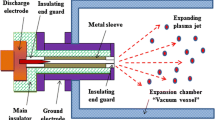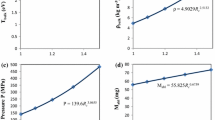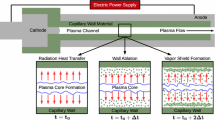Abstract
Future fusion reactors are expected to experience hard current disruptions that quench the confined plasma and depositing the energy on the plasma facing materials, thus causing surface ablation and the evolving aerosol expands into the reactor chamber. The plasma flow following a disruption event can be simulated experimentally and computationally using confined capillary discharges, which generate heat fluxes (up to ~80 GW/m2) typical to those expected in fusion reactors during a disruption. Computational technique to investigate the effect of plasma temperature on the adiabatic compressibility index has been investigated using a pulsed disruptive capillary electrothermal plasma source with a converging–diverging transition nozzle at the exit attached to the expansion regions. The plasma is formed in the capillary due to thermal decomposition of the ablating inner wall followed by subsequent ionization of the decomposed material. This work is particular to the cases where the ejected particulates coming out from a heat-load affected surface or arc-triggered plasma source orifice are at the sonic speed. The converging section in the nozzle provides a transition from the capillary exit subsonic condition to sonic state, which allows for observing the effect of temperature on the supersonic isentropic expansion. Mathematical model has been developed for effective atomic number (Z eff ) as function of the plasma temperature and has been used to model the adiabatic compressibility index (γ p ) of the plasma. Plasma parameters along the axial direction of the flow in the transition and the expansion regions are obtained.














Similar content being viewed by others
References
J. Dyvik, J. Herbig, R. Appleton, J. OReilly, J. Shin, Recent activities in electro-thermal chemical launcher technologies at BAE systems. IEEE Trans. Magn. 43(1), 303–307 (2007)
D. Motes, J. Ellzey, S. Levinson, J. Parker, F. Stefani, D. Wetz, A Study of Electrothermal Launcher Efficiencies And Gas Dynamics. in Proceedings of 14th Electromagnetic Launch Technology Symposium (Victoria, British Columbia, 2008), pp. 1–6, 10–13 June 2008
A.L. Winfrey, M.A. Abd Al-Halim, J.G. Gilligan, A.V. Saveliev, M.A. Bourham, Modeling of an ablation-free electrothermal plasma pellet accelerator. Fusion Sci. Technol. 60(2), 480–485 (2011)
T.E. Gebhart, R.T. Holladay, M.J. Esmond, A.L. Winfrey, Optimization of fusion pellet launch velocity in an electrothermal mass accelerator. J. Fusion Energ. 33(1), 29–32 (2014)
J.R. Echols, A.L. Winfrey, Ablation of fusion materials exposed to high heat flux in an electrothermal plasma discharge as a simulation for hard disruption. J. Fusion Energ. 33(1), 60–67 (2014)
N.M. AlMousa, A.L. Winfrey, J.G. Gilligan, M.A. Bourham, Radiative heat transport through vapor plasma for fusion heat flux studies and electrothermal plasma sources applications. J. Nucl. Energy Sci. Power Gener. Technol. 3(1), 1–7 (2014)
M.A. Abd Al-Halim, M.A. Bourham, Characterization of short intense pulsed electrothermal plasma capillaries for use as fusion and launchers heat flux sources. J. Fusion Energ. 33, 258–263 (2014)
E.Y. Choueiri, A critical history of electric propulsion: the first 50 years (1906–1956). J. Propuls. Power 20(2), 193–203 (2004)
Y. Takao, K. Ono, A miniature electrothermal thruster using microwave-excited plasmas: a numerical design consideration. Plasma Sources Sci. Technol. 15, 211–227 (2006)
T. Edamitsu, H. Tahara, Experimental and numerical study of an electrothermal pulsed plasma thruster for small satellites. Vacuum 80(11/12), 1223–1228 (2006)
E.Y. Shcolnikov, M.Y. Guzeyev, S.P. Maslennikov, A.V. Melnlk, A.V. Chebotarev, Flow dynamics and microparticles acceleration in the electrothermal launcher. IEEE Trans. Magn. 35(1), 240–244 (1999)
K. Kim, D.R. Peterson, A low aspect ratio electrothermal gun for metal plasma vapor discharge and ceramic nanopowder production. J. Mech. Sci. Technol. 22, 1408–1416 (2008)
J.R. Echols, A.L. Winfrey, J.M. Nowak, M.A. Bourham, Evaluation of Materials Deposited By A Novel Electrothermal Plasma Technique. in Proceedings of 19th Pulsed Power Conference (PPC) (San Francisco, CA, 2013), pp. 1–6, 16–21 June 2013
J. Cambier, M. Young, L. Pekker, A. Pancotti, Capillary Discharge Based Pulsed Plasma Thrusters. in Technical Paper, Air Force Research Laboratory, AFRL-PR-ED-TP-2007-400, August 2007
T.C. Lilly, A.D. Ketsdever, A.P. Pancotti, M. Young, Development of a specific impulse balance for capillary discharge pulsed plasma thrusters. J. Propul. Power 25(3), 823–826 (2009)
V. Serini, Polycarbonates, Ullmann’s Encyclopedia of Industrial Chemistry, Wiley, 2000. doi:10.1002/14356007.a21_207
R. Majumdar, J.G. Gilligan, A.L. Winfrey, M.A. Bourham, Supersonic flow patterns from electrothermal plasma source for simulated ablation and aerosol expansion following a fusion disruption. J. Fusion Energ. 33(1), 25–31 (2014)
R. Majumdar, J.G. Gilligan, A.L. Winfrey, M.A. Bourham, Scaling laws of bulk plasma parameters for a 1-D flow through a capillary with extended converging-diverging nozzle for simulated expansion into fusion reactor chamber. J. Fusion Energ. (2015). doi:10.1007/s10894-015-9899-2
M.M. Goodsitt, E.G. Christodoulou, S.C. Larson, Accuracies of the synthesized monochromatic CT numbersand effective atomic numbers obtained with a rapid kVp switching dual energy CT scanner. Med. Phys. 38(4), 2222–2232 (2011)
K.G. Sing, Effective atomic number studies in different body tissues and amino acids. Indian J. Pure Appl. Phys. 40, 442–449 (2002)
V.P. Singh, N.M. Badiger, N. Kucuk, Determination of effective atomic numbers using different methods for some low-z materials. J. Nucl. Chem. 725629, 2014 (2014). doi:10.1155/2014/725629
Mishin G.I., Equation of state for a weakly ionized gas-discharge plasma. Tech. Phys. Lett. 23(7), American Institute of Physics, (1997)
R. Locht, M. Davister, “The dissociative electroionization of carbon dioxide by low-energy electron impact, the C+, O+ and CO+ dissociation channels. Int. J. Mass Spectrom. Ion Process. 144, 105–129 (1995)
D.J. Goebbert, L. Velarde, D. Khuseynov, A. Sanov, C-H bond dissociation energy of malononitrile. J. Phys. Chem. Lett. 1, 792–795 (2010)
Author information
Authors and Affiliations
Corresponding author
Rights and permissions
About this article
Cite this article
Majumdar, R., Bourham, M. Effect of Plasma Temperature and Nonlinearity of the Adiabatic Compressibility Index on Flow Parameters for Hypersonic Aerosol Expansion Following a Plasma Disruption. J Fusion Energ 34, 1269–1277 (2015). https://doi.org/10.1007/s10894-015-9960-1
Published:
Issue Date:
DOI: https://doi.org/10.1007/s10894-015-9960-1




